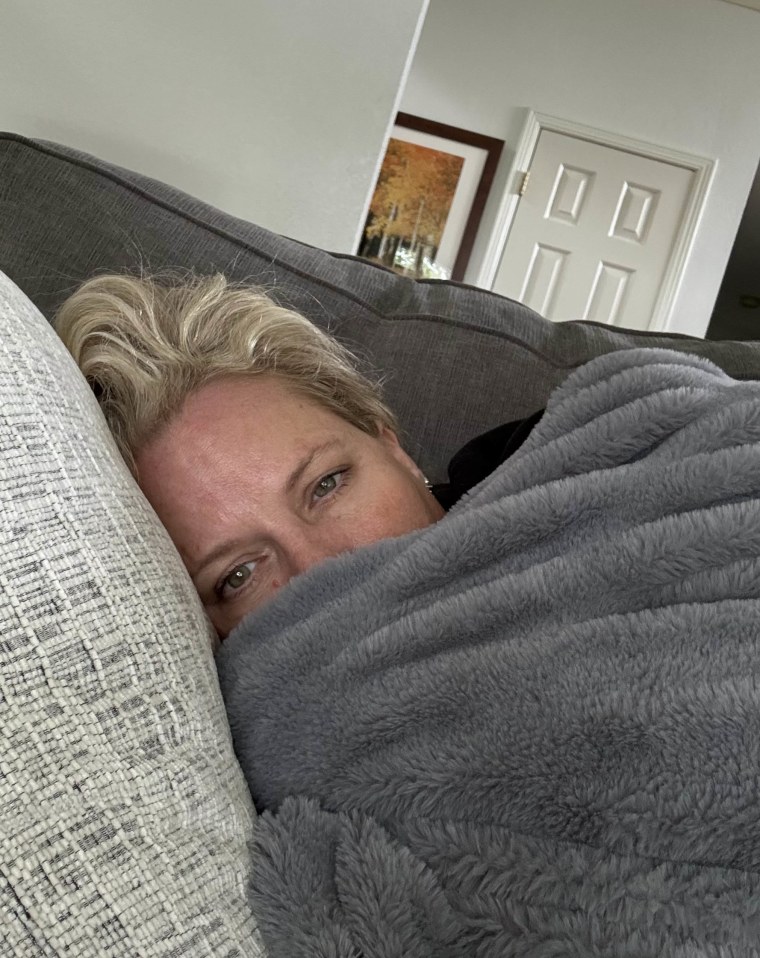Today
More than a decade ago, Kirsten Stein began searching for her young son and panicked when she couldn't locate him.
“I couldn't find it and my daughter had to remind me that she had already left it at school,” the 54-year-old from Marin County, California, told Today. “I had huge gaps in my short-term and long-term memory.”
Although realizing that her little boy was safe was a relief, Stein became increasingly concerned about his health. She had been experiencing disorientation, dizziness, sleeping problems, facial paralysis and “numbness and tingling in her arms, legs, hands and feet,” she recalled.
She visited 15 doctors to try to understand why, but the doctors dismissed her symptoms, from stress to bad allergies. Within three years, she was diagnosed with neurological Lyme disease.
“It was terrifying to be constantly told that there was nothing wrong with you,” Stein recalls. “I have been on this journey for 14 years and I would say that my life is very different. “It is better than the worst days of the illness and treatment, but I miss my old life.”
A serious case of the flu
Over Labor Day weekend 2010, Stein experienced “a bad case of the flu,” as she describes it. Fever, chills, headache, fatigue, muscle and joint pain can be the first symptoms of Lyme disease, according to the US Centers for Disease Control and Prevention (CDC).
Shortly afterward, unusual symptoms began to appear. She realized that her facial muscles were not working properly, she felt that her brain was “on fire” and she was suffering from dizziness, she said.
Stein also had difficulty pronouncing certain words, remembering what had happened a week before, or events from his past.
At the time, Stein was running, mountain biking, and CrossFit, but soon found herself too exhausted to continue pursuing them.
“I could lift 220 pounds in CrossFit, and at three months I could barely hold a pencil,” he explains. “I felt extremely fragile; “I knew something was wrong and that my life had changed overnight.”
Stein became “extremely concerned” and visited 14 doctors. But everyone ruled it out. “All my tests came back fine, so there was nothing wrong with me,” she recalled.
Doctors blamed her symptoms on the stress of motherhood or allergies, which Stein didn't agree with.
He once thought he might have Lyme disease, but doctors ruled that out as well. They did not believe she could have been exposed to disease-carrying ticks in California. Additionally, Ella Stein never found a tick or had a rash, which many consider the telltale sign of a Lyme infection.

“I wasn't looking for ticks,” she said, adding that she also didn't know ticks could transmit Lyme disease in her home state.
Then Stein stumbled upon a diagnosis during a doctor's appointment for her daughter.
“He (the doctor) looked at me and said, 'You don't look good.' And I responded: 'Well, I don't feel very well,'” Stein said. “He told me: 'Well, I'm going to diagnose your daughter and I'm going to help diagnose you.' And I thought, 'Well, you're doctor number 15, so good luck.'”
Three months later, blood work from a local lab revealed she had Lyme disease, and subsequent testing from the CDC confirmed it.
Neurological Lyme disease
Lyme disease is caused by blacklegged ticks, also known as deer ticks, which carry the bacteria Borrelia burgdorferi, according to the CDC.
After being bitten by a tick carrying Lyme disease, people may experience flu-like symptoms, such as fever, muscle and joint pain, and swollen lymph nodes. Although some develop a rash, also known as erythema migrans, it only occurs in 70-80% of Lyme sufferers, the agency noted.
“The early symptoms, say in the first couple of months, are consistent with a summer flu,” Wendy Adams, director of research grants and advisory board member for the Bay Area Lyme Foundation, told Today. “If you ask doctors in the Northeast (where Lyme disease is common), they'll say, 'I know sometimes the summer flu is a tick-borne disease.' So they will (investigate) that immediately.”
For Lyme sufferers who do not receive immediate treatment, symptoms can appear throughout the body. Infection that is left untreated and spreads to other parts of the body, such as the heart or brain, is called disseminated Lyme disease. About 60% of cases of untreated Lyme disease can develop into disseminated Lyme disease, according to the CDC.
Since the bacteria that cause Lyme disease can travel to the brain, “it is not a surprise that this infection causes neurological symptoms,” Adams explained.
According to the CDC, symptoms of neurological Lyme disease include:
- Numbness
- facial drooping
- Pain
- Visual disturbances
- Fever
- Rigid collar
- Intense headache
Reports from patient records highlight that these changes are intensely worrying.

“Neurological symptoms are some of the most common and devastating,” says Adams. “People have memory problems like, 'I can't find my way home. I don't know people I've had in my life for years. I can't remember things for my kids.'”
Although the neurological symptoms are serious, there is less awareness around this manifestation of Lyme disease. Adams said it's partly because current tests are less likely to detect neurological Lyme.
This can mean a delay in diagnosis, and patients often feel overwhelmed and sad that they cannot find a reason for their symptoms.
“They go from doctor to doctor. They are often dismissed as malicious, or diagnosed with depression and given an antidepressant,” Adams said. “This infection can manifest itself in several ways. “It can do it as meningitis, but also as a mental illness.”
People can develop depression, obsessive-compulsive symptoms and even suicidal ideation, he noted.
“This puts them on the path of treating the mental disorder without evaluating or looking for an infection that is causing the neurological symptoms,” Adams added.
Treatment for disseminated Lyme disease includes 21 to 28 days of antibiotics, according to the National Institute of Allergy and Infectious Diseases. Neurological Lyme patients typically receive intravenous antibiotics, but research is lacking on the most effective treatments for the disease.
The Bay Area Lyme Foundation funds Lyme disease research to contribute to better understanding of the condition. Researchers at the Tulane National Primate Research Center, led by Dr. Geetha Parthasarathy, have been examining non-human models to better understand it and its treatment.
“Delay in diagnosis is one of the main problems for people with persistent illness,” Adams said. “The bacteria have more time to establish the infection. It also makes its eradication difficult.”
Additionally, he also hopes people will focus on preventing tick bites when outdoors:
- Take care of shoes and socks with tick repellent
- Wear long sleeves
- Tuck pants into socks
- When you enter the house, put your clothes in the dryer for 10 minutes to kill any ticks.
- Bathe immediately after being outdoors
- Check yourself and pets

a little calmer
After being diagnosed with Lyme disease, Stein visited a doctor familiar with the disease, who prescribed antibiotics to treat it. Although she feels better, her life is different.
“My kids don't know me as a healthy mother, and that's a challenge,” Stein said. “My youngest son was 3 when I got sick, so he doesn't really know me any other way.”
Although Stein retired from work, she now volunteers with the Bay Area Lyme Foundation and the local high school's mountain biking team. She bought an electric mountain bike and rides when she can.
“That gives me a lot of joy,” he commented. “I try to spend time with friends and family, with my dog and travel a little. That's ok. But it's a little calmer.”
Stein experiences “bad days” and may need to rest a few more. Over the years, she has sometimes felt alone because few people understand what Lyme disease is.
“I isolated myself because it was difficult to explain what Lyme disease meant physically, mentally and emotionally,” she said. “It is something that cannot be seen physically, so many people have a hard time understanding it.”
Stein hopes her story will raise awareness about Lyme disease.
“This disease, in particular, needs funding for its diagnosis and treatment, so that it is easier for doctors and patients to understand it, be diagnosed and receive the treatment they need,” he concluded.

